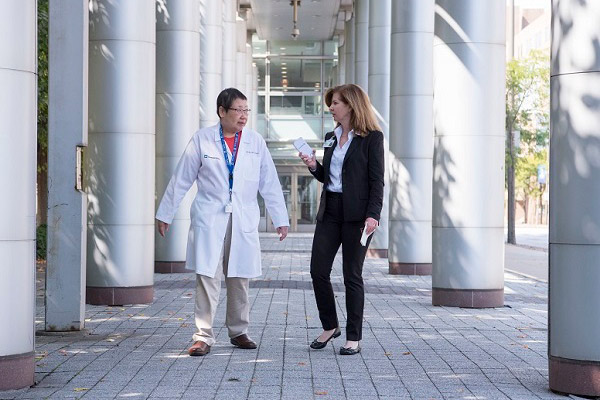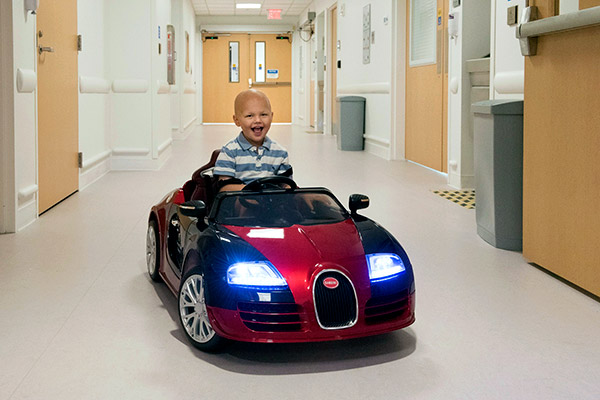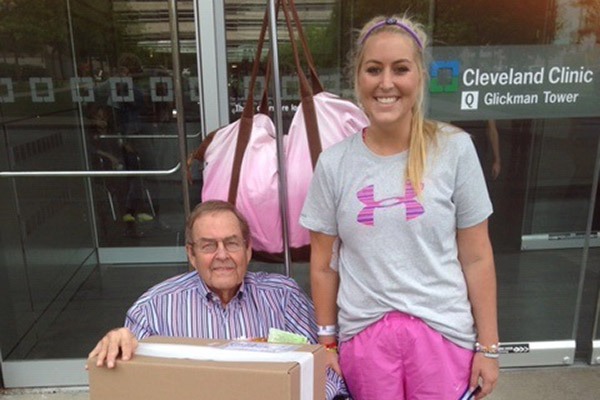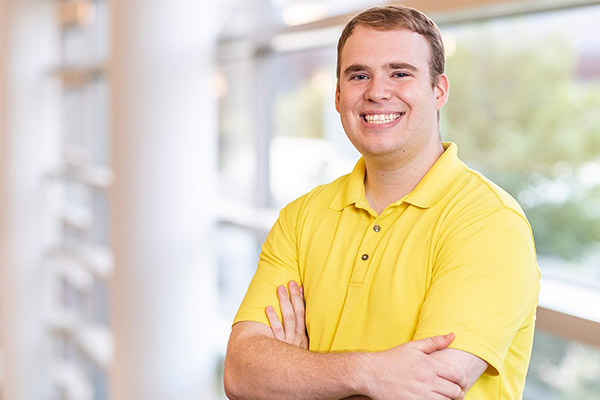3,000 Steps With … Charis Eng, MD, PhD

By Jill Stefancin
Charis Eng, MD, PhD, Chair and inaugural Director of Cleveland Clinic’s Genomic Medicine Institute, has been a pioneer in her field for decades.
In 2010, she was elected to the National Academy of Medicine, one of the highest honors in the fields of health and medicine, for her achievements and leadership in genetics- and genomics-based research and personalized healthcare. In 2018, she received the American Cancer Society’s Medal of Honor, the organization’s highest award, presented to individuals who have made outstanding contributions in the field of cancer. And in August, a new database ranked Dr. Eng among the top 0.01% of published scientific authors in the world out of 7 million eligible scientific authors.
In other words, she’s a brilliant scientist.
She recently met with me outside her office on the fifth floor of Lerner Research Institute and we set off to see her lab as we talked about her work. The lab is unassuming, a large open space lined with metal cabinets and refrigerators. The bright fluorescent overhead lighting illuminates rows of tables, with the shelves above crammed with equipment and boxes, creating the impression of organized chaos. It’s quiet except for our voices, and most of the researchers are seated at desks, focused intently on the computer screens in front of them. Dr. Eng speaks quickly and authoritatively, and her delightful laugh peppers the conversation.
Breast Cancer and the Microbiome
In August, the Gray Foundation awarded a five-year, $1.6 million grant to Dr. Eng and her collaborators to further their study of the connection between the microbiome of the breast and breast cancer. I asked her to explain how this breakthrough could impact the way breast cancer is diagnosed.
“We’ve been studying the microbiome since 2010,” she begins, defining the microbiome as the living community, including bacteria, fungi and viruses, that’s not human yet lives in and on us. “It’s been a long and arduous route because so many bioinformatics – ‘big data’ – techniques were not there and we had to create them. What the Gray Foundation grant has funded us to do is to take our pilot data and ask if the microbiome differs between normal breasts and breasts that have cancer, and what we can do about that. We’ve already shown that normal breast tissue actually has more bacteria than those with cancer.”
Discovering new ways of predicting susceptibility to breast cancer is an urgent need, since more than half of women diagnosed with the disease have no known risk factors and only a small percentage of women with genetic predispositions or environmental-induced risk factors for breast cancer actually develop a malignancy.
Dr. Eng’s breast cancer research also will delve into the role of the immune system. “If you’re talking about bacteria and fungi, the body’s immune system has to do something,” she continues as we navigate through an aisle in the lab. “How does the immune system ‘talk’ to the bugs and how do the bugs ‘talk’ to the immune system? Is it a profitable relationship, where the immune system mounts a response, or is it a destructive one, where certain microbiota can interrupt the immune system and do the opposite and cause cancer to grow? We don’t yet know.”
PTEN Research
Dr. Eng also has done extensive research into the PTEN gene, which, according to the National Institutes of Health, provides instructions for making an enzyme that is found in almost all tissues in the body. The enzyme acts as a tumor suppressor or cancer fighter, which means that it helps regulate cell division by keeping cells from growing and dividing too rapidly or in an uncontrolled way.
“I study Cowden syndrome, caused by germline (inherited) mutations in the PTEN gene,” she says. “People with Cowden syndrome may have a very high risk of breast, thyroid, endometrial, kidney and colon cancer. Cowden syndrome also predisposes to autism, so it’s one of the most common autism genes.
“Imagine, a rare cancer predisposition gene is one of the most common autism genes,” she marvels.
I ask if she was expecting to discover a connection between PTEN and autism. “No, certainly not,” she quickly responds. She says that around the time she came to Cleveland Clinic in 2005, she noticed that an unusual number of the patients in the study had kids and grandkids with autism, so she decided to investigate.
“Let’s just take people with autism and with large heads – that’s what characterizes PTEN disorders – how many have the PTEN mutation?” she wondered. “The answer is that of people with autism and large heads, it could be 20% and that’s high. Of all people with just autism, 2-5 % have a PTEN mutation – that’s huge. If you look at children with large heads and autism, half of them have a PTEN mutation.
“So the discovery was by serendipity … and serendipity helps the prepared mind. I guess we were prepared,” she says with a satisfied chuckle.
This work is continuing: She and a team of researchers published a new study in the October issue of the American Journal of Human Genetics which identifies a metabolite that that may predict whether individuals with PTEN mutations will develop cancer or autism spectrum disorder (ASD).
A True Prodigy
Dr. Eng knew she wanted to be a doctor when she was a toddler. “Yes, when I was 4 years old, I knew I wanted to be a physician and a scientist,” she says. “I had my toy doctor’s bag and my chemistry kit, so that’s what really put it together.” In Singapore, where she grew up, one of her uncles was a professor of medicine and the personal physician to the country’s first Prime Minister, Lee Kuan Yew. “My uncle was very inspiring,” she recalls.
She entered the University of Chicago at age 16, completing an MD and PhD at its Pritzker School of Medicine. She says she did not feel any discrimination because of her gender or age, thanks in part to her genetics professor and mentor, Edward Garber, PhD.
Dr. Eng, who holds the Sondra J. and Stephen R. Hardis Endowed Chair in Cancer Genomic Medicine, believes medical philanthropy is vital. “The traditional federal funding sources want a lot of data. In fact, they probably want the whole project finished before you even go in!” she says, presenting the problem as the classic chicken and egg story: “If you don’t have funding, how are you going to prove it? And if you can’t prove it, you won’t get a cent.”
She is eternally grateful to Mr. and Mrs. Hardis, who have endowed her research chair since 2008. “They’ve gone beyond that even. They’ve provided other funding, all of which was absolutely necessary to do the vital work I just told you about. And it’s the same with the microbiome work. We started from scratch – who would fund us except for philanthropy and private foundations, such as the Gray Foundation?”
A pragmatic optimist, Dr. Eng acknowledges tangible progress in her field. “A lot of the research over the last 25 years has led to the translation of routine clinical care and is now codified in national practice guidelines,” she says. “Research takes a long, long time. I hope the projects I described to you, where there’s a multidisciplinary approach to determine what causes cancer and what causes autism, even though the same gene is affected – I hope that will come to fruition because it will help prevent cancer and autism.”
Vroom, Vroom: Fun Distraction Helps Pediatric Patients

After watching a video of 5-year-old Reid Webster motoring around the halls of Cleveland Clinic Children’s Outpatient Center in a sporty red convertible toy car, Bob Serpentini was thrilled.
“I was just watching him get into the car and seeing the excitement on his face. It’s fun to be a part of that,” he says. ”You feel like you want to help, so when it came to the cars, I thought what a great thing to give kids a little light of enjoyment.”
The owner of Serpentini Chevrolet made a generous gift to Cleveland Clinic Children’s for the purchase of six miniature electric cars that kids can jump in and use to “drive” themselves to their appointment or procedure. The cars are in a variety of locations, including main campus and Cleveland Clinic Children’s Hospital for Rehabilitation.
The kid “drivers” steer and control the speed of the cars, but caregivers with remote controls can override for safety. Specially designed for children ages 3-7, the cars have seat belts, a working radio and a horn for blasting tunes and bringing smiles to the faces of passersby. “When patients and families come to the hospital for procedures, there’s a lot of anxiety surrounding that,” says Brittany Irwin, CRNA, Senior Director of Certified Registered Nurse Anesthetists at Cleveland Clinic’s Anesthesiology Institute.
“As anesthesia providers, we’ve made a career out of keeping patients safe and reducing their pain and anxiety, and distraction is a wonderful tool to do that. We’re hoping that by offering the opportunity to drive in the cars instead of riding on the traditional gurney that it will serve as a distraction as well as give them a little bit of joy in their day.”
Bob says he was inspired to make a gift to Cleveland Clinic Children’s because he has vivid memories of when his nephew was treated for a neuroblastoma in the early ’90s. “He was young. I think he was 11 or 12 months old,” Bob says. “He spent a lot of time at Cleveland Clinic. And, frankly, what just blew me away was the love and the care that he got, because, unfortunately, it was not going to be a good ending. But the doctors and nurses couldn’t have been more kind or attentive.”
Bob remembers telling his brother and sister-in-law late one night to go get some sleep and he’d stay with their son. “It was like 2 in the morning and these three nurses who were off-duty showed up just to see how he was doing,” Bob recalls, his voice incredulous. “That just blew me away. Of course you’re going to have world-class doctors, but it’s more than just that. I thought to myself, ‘There’ll be a day when we’ll be able to step up and do some things and this is where we’ll help.’ So I’m happy that I’m able to give back and help these children. You feel like you can never do enough.”
How You Can Help
Your gift to Cleveland Clinic Children’s helps our littlest patients thrive because it supports groundbreaking research, innovative treatments and world-class care. Or, like Bob Serpentini, you can designate where you’d like your gift to make an impact.
Gifts to Medical Research Assuage Grief

Victoria “Torsie” Haugli and her grandfather, John “Jack” Lally, were close and shared much in life, including pragmatism, says Torsie’s mother and Jack’s daughter, Dana Haugli. Their realistic outlook helped them weather tough times – Torsie’s sudden diagnosis of a rare and aggressive lymphoma and Jack’s struggle with emphysema that led to a lung transplant. Both passed away in 2015, Torsie on May 10 at age 23, and Jack on June 18 at age 79.
Jack made numerous trips to Cleveland Clinic over the course of several years. In a 2013 interview for Catalyst magazine, he acknowledged at first resisting the idea of having a transplant operation.
“I was getting worse all the time,” he said. “I was on oxygen 24 hours a day. That was no life at all.”
His family encouraged him to have the procedure, and on Easter Sunday 2010, he had a single-lung transplant.
During the course of Jack’s treatment before and after the transplant, Dana and her mother, Louise Lally, often traveled with her father from their home in Lexington, Kentucky, to Cleveland Clinic, where she saw the excellent care her father received. She says that she and her mother also experienced great warmth and caring from his medical team.
This is why, when Torsie suddenly fell ill on the morning of her college graduation in May 2014, was rushed to the hospital near her home and diagnosed with anaplastic large cell lymphoma (ALK), “there was an urgency to go to Cleveland Clinic,” Dana says. “I knew the system and the people, had a familiarity with it and a confidence going up there. They’re very good at covering everything and taking care of you as a patient and as a family.”
Over the next year, Torsie and her grandfather were at Cleveland Clinic for treatment at the same time, she for bone marrow transplant and he for hip surgery. Dana recalls her daughter making her way to her grandfather’s hospital room. She describes a particularly poignant moment as Torsie and Jack sat together, gazing out the window “at that cold snow.”
“We made the best of it we could,” Dana says. “We managed to make Cleveland Clinic our home in the year that we were there, with the overlapping care of my father and daughter. They had a lot of similar experiences. Even though her care was pediatric, she was on a floor with adults. That’s hard for a young person who isn’t a child anymore but still needs the support of her parents. The nurses were very sensitive to her needs, and several became close friends with her.”
Dana says she, herself, walked 10 miles in one day, going back and forth between buildings at Cleveland Clinic where Torsie and Jack stayed. She took in her surroundings and was moved by the artwork. “It’s a nice space for healing and for families,” she says. “And even though Cleveland Clinic is a huge campus, we felt like we were in a neighborhood. Even with someone like Torsie, with multiple issues and moving to multiple buildings for neurological, blood, rehab and radiation, we still felt comfortable.”
The family’s experiences led to several gifts for lung transplantation and lymphoma research by Jack’s surgeon, Marie Budev, DO, and Torsie’s physician, Deepa Jagadeesh, MD.
In recognition of the family’s support, a meditation space at the Cleveland Clinic Cancer Center has been named the Torsie Haugli and Lally Family Meditation Suite.
“The named suite means so much to our family because it gives us a connection to Cleveland Clinic and is a great honor for Torsie and Jack, who have a special place in our hearts,” says Dana’s brother, Tim Lally. “They had bigger-than-life personalities and connected with everyone they met. Hopefully, the suite will provide comfort and a break from the stress for many patients, families and caregivers.”
How You Can Help
Your gift to Cleveland Clinic in memory of a loved one can support medical research, patient care programs and services, or a specific designation selected by you.
Mystery Solved: Rare Genetic Disorder Treated, Thanks to Specialized Care

When he was 17 and a busy high school junior in Chicago, Michael Ambrose came down with what he thought was a nasty case of stomach flu. However, when the pain and discomfort continued for weeks, his parents took him to a doctor — and then to several more, all of whom had difficulty determining the cause. In fact, Michael's case became a subject at medical conferences as his physicians strived to solve the mystery.
“One of them said to me that my official diagnosis was, ‘You've got some messed-up ‘blank’ going on,’” he recalls.
Eventually, through a colonoscopy and genetic testing, the cause was found to be a rare, hereditary disease called juvenile polyposis syndrome, or JPS. Only about 1 in 100,000 people have it, and those who do are at increased risk of developing colorectal, stomach, small intestine and pancreatic cancer. The genetic test also discovered a rare blood disorder called hereditary hemorrhagic telangiectasia (HHT), caused by the same genetic mutation responsible for the JPS.
Over time, the illness severely impacted Michael's life. He had endoscopies and colonoscopies every six months, with removals of “dozens and dozens” of polyps in his colon, intestines and stomach. Through it all, he still managed to hold down a stressful job as a staffer for a congressman in Washington, D.C. Finally, at the age of 27, he suddenly became tired, dizzy and winded. After several days he couldn’t walk or even lift his arm without getting exhausted and was on bed rest for several weeks.
“I had no energy at all, and my hemoglobin count kept falling,” he says. “It was around 5, when 'normal' is in the 12-to-20 range.”
The cause was internal bleeding from a polyp so large that doctors at several top hospitals said they could not remove it endoscopically. Instead, they advised, Michael should have part of his stomach removed in a surgical procedure known as a gastrectomy.
Unwilling to have such a radical surgery, especially at such a young age, Michael considered going to Japan, where less invasive, endoscopic techniques for his illness are available. Then, his primary care doctor, Santiago Candocia MD, helped him get an appointment with Amit Bhatt, MD, a gastroenterologist at Cleveland Clinic's Sanford R. Weiss, MD, Center for Hereditary Colorectal Neoplasia, who uses these techniques. Dr. Bhatt and other physicians and caregivers in the Weiss Center specialize in rare hereditary gastrointestinal polyposis and non-polyposis conditions.
In the fall of 2017, Michael first met with Dr. Bhatt; in January 2018, he had the endoscopic procedure. Normally, it's a same-day outpatient procedure, but because Michael lived out of state, he remained at the hospital for a few days as a precaution, Dr. Bhatt says.
Since then, Michael has lived a normal life with a normal diet, and even started a new job that requires a fair amount of travel.
“I can't say enough about Dr. Bhatt and his team,” Michael says.
The Weiss Center “is one of largest polyposis centers in the world and one of the biggest hereditary polyposis centers in North America,” Dr. Bhatt says. “We see a lot of patients because we specialize in their care.”
Polyposis begins in the first decade of life, and most patients are symptomatic by the age of 20, Dr. Bhatt says. “A lot come to us when they are in their 20s and 30s, and the last thing you want at that age is surgery that changes your lifestyle.”
Dr. Bhatt performs a high volume of endoscopic procedures because he offers a specialized, diverse skill set, combining two different techniques. He developed these skills through extensive medical training at Cleveland Clinic and then in Japan, a country where gastric cancer has been one of the most common cancers for the last decade, he says.
Because there is no cure for Michael's disease, he probably will need more procedures in the future, Dr. Bhatt says. Yearly exams are required because "we never want the disease to get away from us.”
For his part, Michael says he is willing to do whatever it takes to continue leading a normal life.
“So much of it is just having the right outlook, to count your blessings,” he says. “I have a very supportive family, who are great advocates for my care, and Cleveland Clinic is phenomenal. Everything there is top-notch, from the facilities to the nurses and staff. Dr. Bhatt is a lifesaver, and my whole family is so thankful to him.”
How You Can Help
Your gift to Cleveland Clinic has an immediate and lasting impact, helping to fund research, medical education, and patient programs and services – or a designated area of your choosing.

